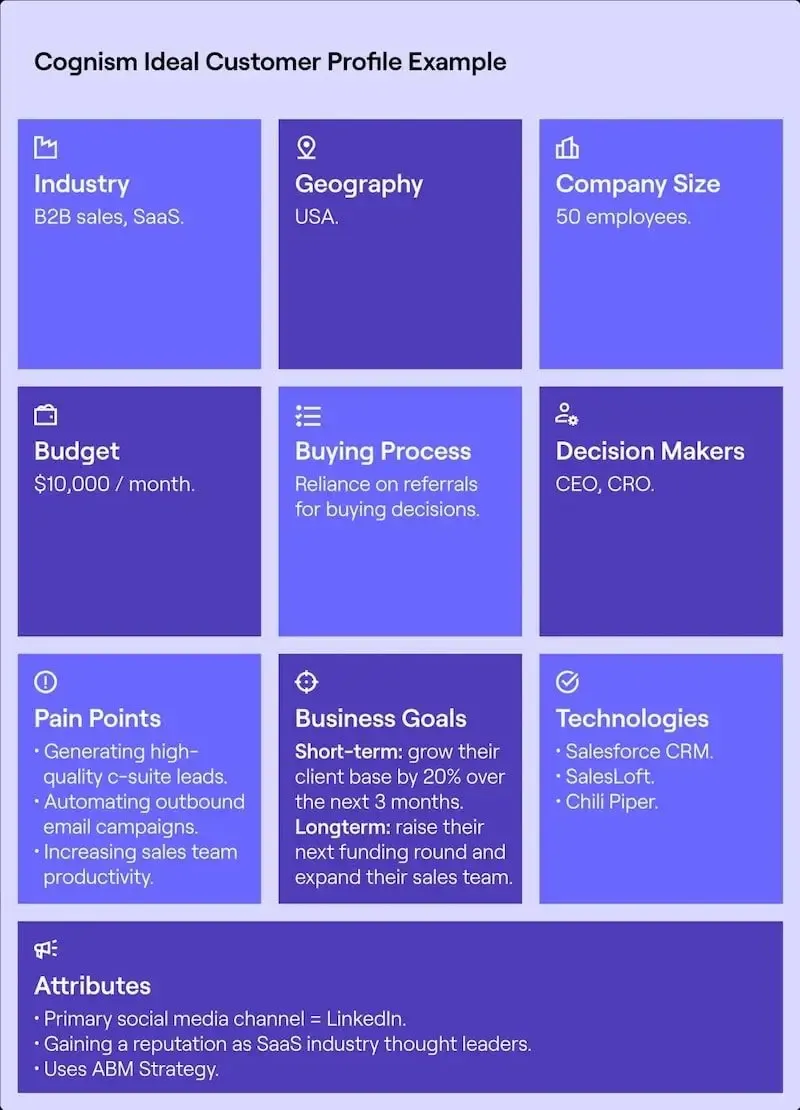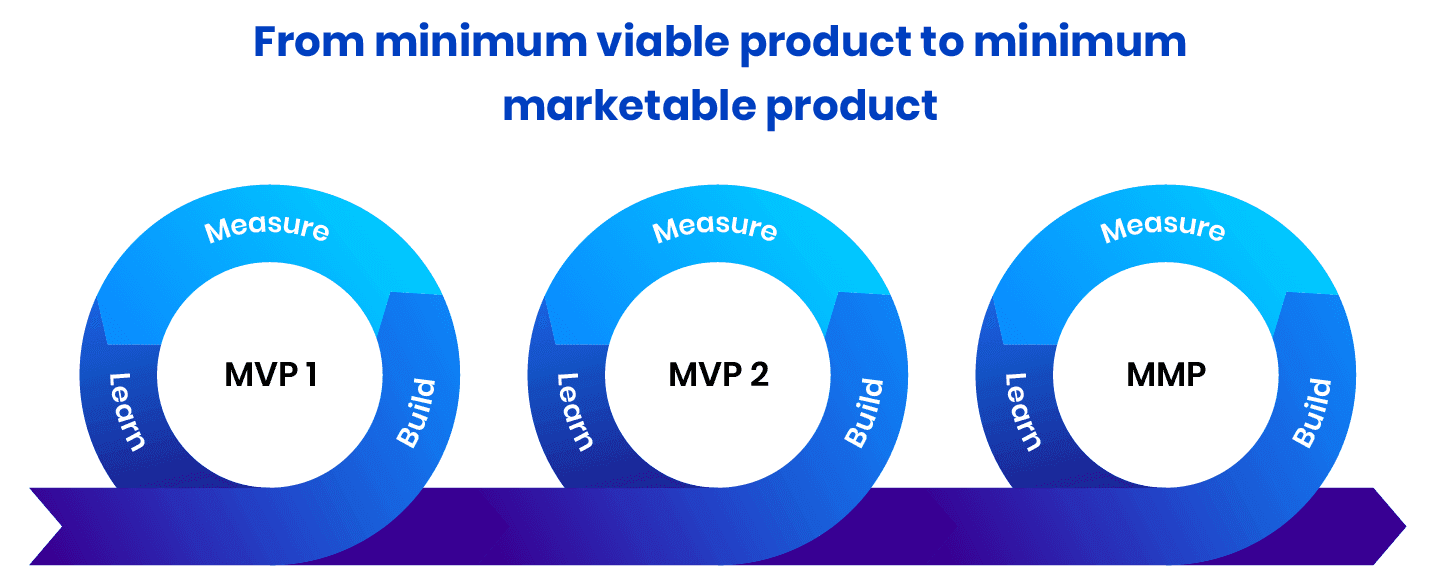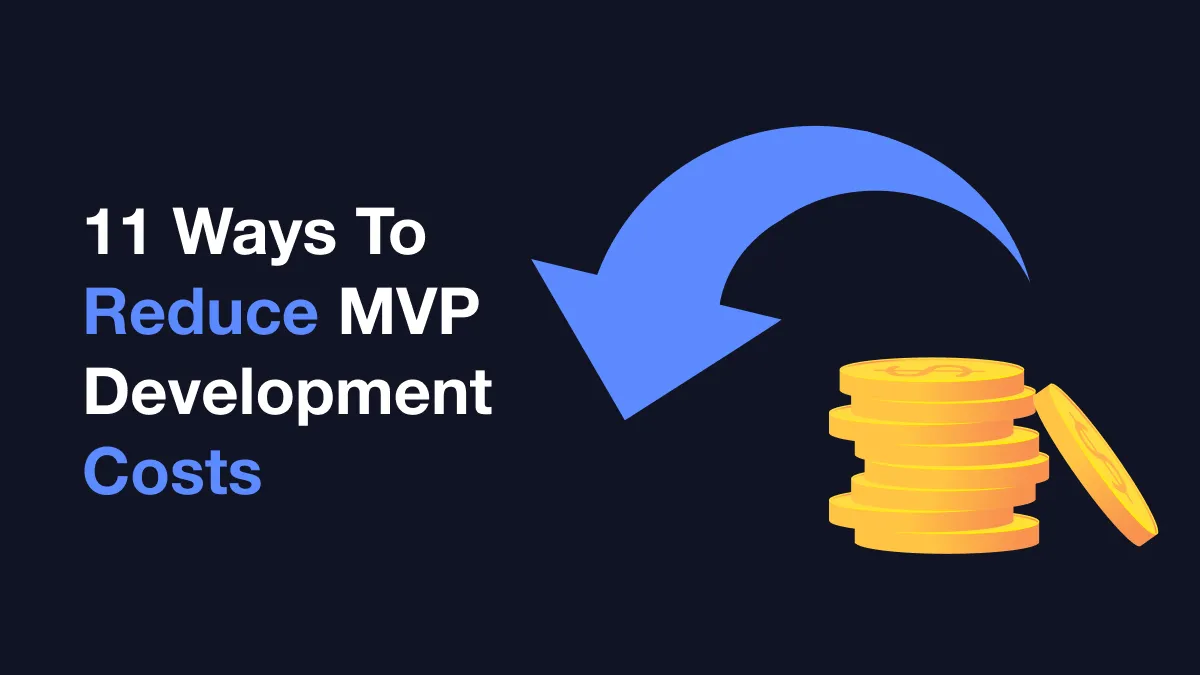EXPLORE
Got a Question? Connect with our experts.
Talk to an Expert
Got a Question? Connect with our experts.
Talk to an Expert
Developing a Minimum Viable Product (MVP) is one of the most effective ways to validate your idea.
However, it does require a certain level of funding, which can pose a significant challenge for new entrepreneurs, as securing funds based solely on an idea is often quite difficult.
Investors typically prefer to see some level of traction before committing to an investment, leaving many entrepreneurs in a difficult position.
Fortunately, there are strategies to reduce the costs associated with MVP development.
In this article, we'll explore 11 ways to reduce MVP development costs.
What is an MVP?
While it's tempting to go straight for a polished, full-featured app, building an MVP (Minimum Viable Product) is often the smartest and most cost-effective way to test your idea and gain early user feedback.
Let’s go back to understanding an MVP (Minimum Viable Product).

MVP is a simplified version of your app that includes only the core features necessary to validate your idea and solve your target users' problems.
Rather than building a fully-featured, polished product, you focus on the essential functionality that allows you to test the concept, gather feedback, and iterate based on real user data.
Starting with an MVP allows you to save a substantial amount of funds by focusing solely on developing the features that deliver the greatest value to your customers.
But let's explore how we can go even a step further and save even more on MVP development.
How Does the MVP Development Approach Help Save Costs?
Doesn't matter if you are a first-time entrepreneur, serial entrepreneur or a big corporation trying to introduce a new product to the market MVP development approach will help you save costs.
When it comes to MVP development your main goal should be:
GET A FIRST PAYING CUSTOMER AT THE LOWEST POSSIBLE COST
The MVP development approach is all about getting your product in front of your customers as fast as possible and cheaply as possible.
Naturally, the final cost will depend on the complexity.
MVPs are less complex versions of the final product, so don't hesitate to leave some features for later.
Luckily, there are many different types of MVPs, ranging from simple ones that are focused on validating an idea through marketing without a product to more complex ones.
How much does MVP app development cost?
The cost of developing an MVP can vary widely depending on factors like the complexity of the app, platform requirements (iOS, Android, or both), the size of the development team, and the location of your developers.
Here’s a general breakdown:
| MVP | Features | Cost |
|---|---|---|
| Low-End MVP | A basic app or website with limited functionality, simple design, and minimal features. | $20,000 – $40,000 |
| Mid-Range MVP | A more sophisticated product with additional features, decent design, and mobile/web compatibility. | $40,000 – $80,000 |
| High-End MVP | A feature-rich MVP with complex backend systems, third-party integrations, custom design, and multi-platform support. | $80,000 – $150,000 or more |
Now, you might be thinking, “I could build a really simple MVP for under $30,000 and call it a day.” But remember, quality matters. A rushed, minimal product might not give you the traction you need.
Let’s look at how you can reduce MVP app development costs while still delivering a valuable product that can scale.
11 Ways to Reduce MVP App Development Costs
1. Start with a Clear, Focused Vision
Before you even think about coding or design, make sure you have a crystal clear vision of your app’s core value proposition.
- What pain points do my potential customers face, and how urgent are they?
- What are my customers currently doing to solve this problem?
- Why would someone choose my solution over existing alternatives?
- What unique advantage does my product offer that differentiates it from competitors?
- What key metrics will indicate the success or failure of my MVP?
- How will I gather feedback from early users to improve the product?
- What assumptions am I making about the problem, the audience, and the solution, and how can I test them?
- What is my long-term goal for the product if the MVP proves successful?
- Am I prepared to pivot or refine my vision based on the feedback and data I receive?
Answering these questions will help you stay focused.
As your product grows, it will evolve, and change, so it's generally a good practice to revisit these questions and answer them again to make sure you are sticking to your vision and what has changed.
The more specific your idea is, the less likely you are to waste time and money on unnecessary features.
Remember, an MVP is about essentials.
Build just what’s needed to test your idea, not an app heavily loaded with features.
Tip: Create a one-page document outlining your app’s key features and goals. This simple blueprint can serve as your roadmap and help keep your project focused on what matters most.
2. Create an Ideal Customer Profile
One of the most important steps in reducing MVP development costs is understanding your users.
Spend time conducting user research before jumping into development.
By identifying your target user’s pain points early on, you ensure you're building something people actually need.
This research prevents you from wasting money on features that may not resonate with users.
Below is a blueprint for creating an ideal customer profile.

source: cognism
A great way to approach creating an ideal customer profile is to try to literally picture your ideal customer profile.
Dive into the specifics as much as you can, consider details like where they live, the type of clothes they wear, their favorite food, and the kind of car they drive.
The more details, the better.
3. Build Your MVP for Early Adopters, Not the Mass Market

source: reddit
The worst thing you could do is build an MVP that's for everybody. That MVP is doomed to fail.
Focus on early adopters.
With your ideal customer profile identify users who are willing to test new products and provide feedback, rather than the masses.
These users are often more forgiving of bugs and imperfections, giving you valuable insights to refine your product.
They can help you avoid spending on features that might not be relevant to a broader audience just yet.
Tip: Target niche communities on platforms like Reddit, Product Hunt, or LinkedIn groups. Engage with potential users directly to collect honest feedback that will help you make informed decisions without overspending.
4. Clearly Define Your MVP’s Core Features
Once you have validated your idea with research, it's time to define the MVP’s essential features.
It’s easy to get carried away with adding extra features, but remember, MVPs are all about proving your concept.
Every additional feature adds time and cost.
Stick to the core features that address your users' primary needs.
Avoid the temptation to add extra features that might seem cool but aren't necessary at this stage.
By focusing solely on the features that help you solve your target audience’s primary pain points, you can keep costs low while increasing the chances of finding product-market fit.
Multiple techniques can help you measure the impact that a feature will have on your core target audience. This helps you decide which features to include in the first version of your MVP.
Some of the feature prioritization frameworks are:
- RICE Framework
- MoSCoW Method
- The Priority Matrix
- Kano Model
- Story Mapping
Ideally, you would go through all of them and analyze the results carefully to know what features to include in the first version of your MVP.
5. Use Pre-Built Templates and Frameworks
To speed up the development process and reduce costs, leverage pre-built templates and frameworks.
Open-source libraries, code snippets, and frameworks like React Native, Flutter, or Django can save you time and money by eliminating the need to start from scratch.
These tools also help ensure your app is built on a stable foundation, which reduces the risk of costly technical debt down the line.
Tip: Browse platforms like GitHub or Stack Overflow for open-source tools and libraries that align with your app's needs.
6. Outsource to the Right Team
Hiring a local in-house team might seem like a good idea, but outsourcing to skilled developers from regions with lower labor costs (such as Eastern Europe, India, or Latin America) can provide significant savings without sacrificing quality.
One of the biggest advantages that outsourced teams have over a building a local in-house team is their experienced and well-established teams.
For example, our team at globalsoft has an average rating of 4.7 at Glassdoor a website where current and former employees anonymously review companies. With an average employment lasting 4.5 years.
Many offshore development teams have extensive experience in building MVPs and can offer competitive rates compared to local agencies or freelancers.
Tip: Search for agencies or freelancers who specialize in MVP development and check their portfolio for relevant experience. A proven track record in building MVPs will ensure you get the best value for your budget.
7. Adopt Agile Development Practices
Agile development is a method where you build and release your app in small, incremental steps, called “sprints.”
This approach allows you to test each feature, gather user feedback, and make changes early, before they become expensive to fix.

Source: RubyGarage
It also reduces the risk of developing unnecessary features and helps you stay on budget.
Tip: Work closely with your development team to break the project into smaller, manageable chunks and track progress during each sprint. Regular feedback and iteration will save you money in the long run.
8. Leverage Cloud Infrastructure
Instead of investing in expensive hardware and maintaining your own servers, use cloud platforms like AWS, Google Cloud, or Microsoft Azure to host your app.
These cloud providers offer scalable and cost-efficient infrastructure that allows you to pay only for the resources you actually use.
Also, cloud platforms come with built-in security, maintenance, and monitoring, saving you time and money.
Tip: Use managed services from cloud providers to reduce the need for an in-house IT team and make scaling easier as your user base grows.
9. Introduce New Features One at a Time
Once your MVP is live, it’s tempting to keep adding new features.
However, introducing new features gradually, each with its own clear hypothesis allows you to assess their impact before moving forward.
This approach helps control costs and prevents you from adding unnecessary features that don’t move the needle.
Tip: Before adding a feature, define a clear hypothesis about its expected impact (e.g., improving user engagement or increasing retention) and test it thoroughly before implementing the next one.
10. Test Early, Test Often
Early testing can save you a lot of money in the long run.
The earlier you start gathering feedback from real users, the sooner you can identify issues that might otherwise become expensive to fix later.
Tools like Figma allow you to prototype and test your app's design and features before committing to full development, saving both time and money.
Tip: Conduct usability testing with a small group of target users to identify pain points early in the design phase. This helps you make informed decisions about which features to prioritize.
11. Automate Where Possible
Automation is a game changer when it comes to reducing development and operational costs.
By using CI/CD (Continuous Integration/Continuous Deployment) tools, you can automate testing, deployment, and updates, which helps streamline development and reduce manual errors.
Automation also frees up your team to focus on building features rather than dealing with repetitive tasks.
Tip: Invest in tools that automate manual testing and code deployment to reduce the need for a dedicated quality assurance team and minimize the potential for human error.
FAQs: Ways to Reduce MVP App Development Costs
1. Can I reduce MVP development costs by outsourcing?
Yes, outsourcing to regions with lower labor costs can significantly reduce your development expenses. Just be sure to hire a team with relevant experience in building MVPs and managing remote communication effectively.
2. How much should I spend on my MVP?
It depends on the complexity, but for a basic MVP, aim for $20,000 - $60,000. However, keep in mind that quality matters, so investing in a slightly higher-quality MVP will help you achieve better user engagement and product-market fit.
3. Can I launch an MVP without a design?
While it’s possible to launch an MVP with basic wireframes or templates, design matters. A well-designed user interface (UI) and user experience (UX) can significantly impact your app’s adoption rate. If your budget is tight, focus on minimalist designs that highlight your core functionality.
4. How do I know if my MVP is successful?
The success of an MVP is measured by its ability to validate your core assumptions about the market and users. Use user feedback, engagement metrics, and conversion rates to evaluate whether your app is solving the problem effectively and whether there’s demand for your product.


Wondering how much your MVP will cost?
Use our free MVP cost calculator to get a tailor-made estimate.
Calculate MVP Costs
Insights From globalsoft's Sales Development Representative Zorica Ćavar
"It's all about focusing on the core features and keeping things simple. At globalsoft, we've seen how leveraging existing tools and testing early can save time, money, and keep the project on track. By sticking to these steps, you can build an MVP that's efficient and effective."
- Zorica Ćavar
Conclusion
Reducing MVP app development costs doesn’t mean cutting corners.
It's about being strategic with your resources, focusing on essential features, leveraging pre-built tools, and collaborating with the right team.
By following these tips, you can minimize your costs while still launching a successful MVP.





